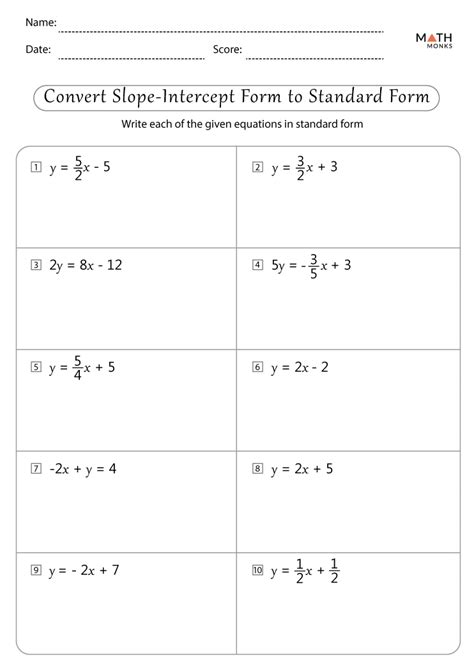The standard form of a linear equation, also known as the general form, is a fundamental concept in algebra. It is used to represent lines in a two-dimensional coordinate plane. The standard form is often denoted as Ax + By = C, where A, B, and C are constants, and x and y are the variables. However, when working with linear equations, it is sometimes more convenient to use the slope-intercept form, which is y = mx + b. In this article, we will explore the concept of converting standard form to slope-intercept form and provide a worksheet to practice this skill.

Understanding Standard Form
The standard form of a linear equation is given by Ax + By = C, where A, B, and C are constants, and x and y are the variables. For example, 2x + 3y = 5 is a linear equation in standard form. In this form, the coefficients of x and y are A and B, respectively, and the constant term is C.
Why Convert to Slope-Intercept Form?
While the standard form is useful for certain applications, the slope-intercept form is often more convenient for graphing lines and understanding their behavior. The slope-intercept form is given by y = mx + b, where m is the slope of the line and b is the y-intercept. The slope-intercept form allows us to easily identify the slope and y-intercept of a line, which are essential for graphing and analyzing linear equations.

Converting Standard Form to Slope-Intercept Form
To convert a linear equation from standard form to slope-intercept form, we need to isolate the variable y. This can be done by subtracting the term with x from both sides of the equation and then dividing both sides by the coefficient of y.
For example, consider the linear equation 2x + 3y = 5. To convert this equation to slope-intercept form, we first subtract 2x from both sides:
3y = -2x + 5
Next, we divide both sides by 3:
y = (-2/3)x + 5/3
Now, the equation is in slope-intercept form, and we can easily identify the slope (m = -2/3) and y-intercept (b = 5/3).
Practice Worksheet
Here are some exercises to help you practice converting standard form to slope-intercept form:
- Convert the linear equation x + 2y = 4 to slope-intercept form.
Answer: y = (-1/2)x + 2
- Convert the linear equation 3x - 2y = -5 to slope-intercept form.
Answer: y = (3/2)x + 5/2
- Convert the linear equation 2x + 5y = 10 to slope-intercept form.
Answer: y = (-2/5)x + 2
- Convert the linear equation x - 3y = -2 to slope-intercept form.
Answer: y = (1/3)x + 2/3
- Convert the linear equation 4x + 2y = 12 to slope-intercept form.
Answer: y = (-2)x + 6

Real-World Applications
Converting standard form to slope-intercept form has numerous real-world applications. For example, in physics, the equation of motion can be represented in standard form, but converting it to slope-intercept form allows us to easily analyze the motion of an object.
In economics, linear equations can be used to model supply and demand curves. Converting these equations to slope-intercept form helps economists understand the behavior of these curves and make informed decisions.
Conclusion
In conclusion, converting standard form to slope-intercept form is an essential skill in algebra. It allows us to easily graph and analyze linear equations, which has numerous real-world applications. With practice and patience, you can master this skill and become proficient in working with linear equations.
We encourage you to try the practice worksheet above and explore more exercises to reinforce your understanding. Share your thoughts and feedback in the comments section below.
What is the standard form of a linear equation?
+The standard form of a linear equation is Ax + By = C, where A, B, and C are constants, and x and y are the variables.
Why convert standard form to slope-intercept form?
+Converting standard form to slope-intercept form allows us to easily identify the slope and y-intercept of a line, which are essential for graphing and analyzing linear equations.
How do I convert standard form to slope-intercept form?
+To convert standard form to slope-intercept form, isolate the variable y by subtracting the term with x from both sides and then dividing both sides by the coefficient of y.
